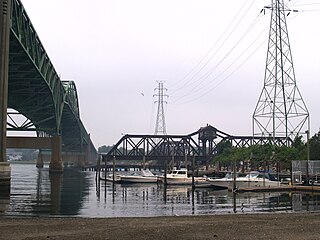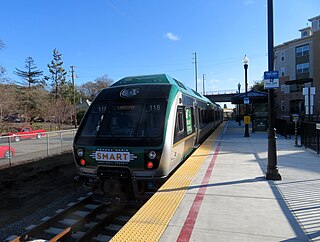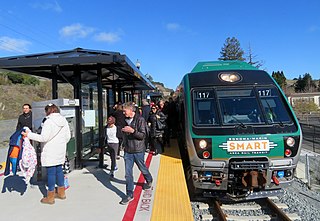
Sonoma County is a county located in the U.S. state of California. As of the 2020 United States Census, its population was 488,863. Its seat of government and largest city is Santa Rosa.

The North Bay is a subregion of the San Francisco Bay Area, in California, United States. The largest city is Santa Rosa, which is the fifth-largest city in the Bay Area. It is the location of the Napa and Sonoma wine regions, and is the least populous and least urbanized part of the Bay Area. It consists of Marin, Napa, Solano and Sonoma counties.

Sonoma–Marin Area Rail Transit (SMART) is a rail line and bicycle-pedestrian pathway project in Sonoma and Marin counties of the U.S. state of California. When completed, the entire system will serve a 70-mile (110 km) corridor between Cloverdale in northern Sonoma County and Larkspur Landing in Marin County. In 2023, the system had a ridership of 749,700, or about 3,400 per weekday as of the third quarter of 2024.

The Northwestern Pacific Railroad is a 271-mile (436 km) mainline railroad from the former ferry connections in Sausalito, California north to Eureka, with a connection to the national railroad system at Schellville. The railroad has gone through a complex history of different ownership and operators but has maintained a generic name of reference as the Northwestern Pacific Railroad, despite no longer being officially named that.

The Petaluma River is a river in the California counties of Sonoma and Marin that becomes a tidal slough for most of its length. The headwaters are in the area southwest of Cotati. The flow is generally southward through Petaluma's old town, where the waterway becomes navigable, and then flows another 10 mi (16 km) through tidal marshes before emptying into the northwest corner of San Pablo Bay.

The Harlem River Lift Bridge is a vertical lift bridge carrying the Metro-North Railroad's Hudson Line, Harlem Line, and New Haven Line across the Harlem River between the boroughs of Manhattan and the Bronx in New York City. The average weekday ridership on the lines is 265,000.

The George and Cynthia Mitchell Memorial Causeway is a set of causeways in Galveston, Texas, United States. Two of the routes carry the southbound and northbound traffic of Interstate 45, while the original causeway is restricted to rail traffic. It is the main roadway access point to Galveston Island. The second access point is Bolivar Ferry.

The San Rafael Transportation Center is an intermodal transportation center located in downtown San Rafael, California. It is a primary transfer point for several local and regional bus operators, and a commuter rail station on the Sonoma–Marin Area Rail Transit (SMART) system.

San Francisco and North Pacific Railroad (SF&NP) provided the first extensive standard gauge rail service to Sonoma County and became the southern end of the regional Northwestern Pacific Railroad. Although first conceived of by Asbury Harpending, who had even obtained many of the right of ways, the SF&NP was bought and subsequently constructed by Peter Donahue, who drove the first spike on August 30, 1869.

The Sakonnet River rail bridge was a swing bridge that spanned the Sakonnet River between Portsmouth and Tiverton, Rhode Island, and provided the only rail link between Aquidneck Island and the mainland. It was closed in 1988 and removed in 2006–07

The Dumbarton Rail Bridge lies just to the south of the Dumbarton road bridge. Built in 1910, the rail bridge was the first structure to span San Francisco Bay, shortening the rail route between Oakland and San Francisco by 26 miles (42 km). The last freight train traveled over the bridge in 1982, and it has been proposed since 1991 to reactivate passenger train service to relieve traffic on the road bridges, though this would entail a complete replacement of the existing bridge. Part of the western timber trestle approach collapsed in a suspected arson fire in 1998.

Santa Rosa Downtown station is a Sonoma–Marin Area Rail Transit train station in Santa Rosa. It opened to SMART preview service on July 1, 2017; full commuter service commenced on August 25, 2017. It is located west of Wilson Street between 4th and 5th Streets, across the U.S. Route 101 freeway from downtown at the site of the ex-Northwestern Pacific Railroad station building. The station is the focal point of the Railroad Square Historic District, a National Register of Historic Places historic district designated in 1979.

Petaluma Downtown station is a Sonoma–Marin Area Rail Transit station in Petaluma. It opened to preview service on June 29, 2017; full commuter service commenced on August 25, 2017. A new platform and facilities were constructed adjacent to the historic Northwestern Pacific Railroad station building, which opened in 1914. It is the system's first station to open in the city, with Petaluma North station set to open later.

Windsor station is a bus station and future Sonoma–Marin Area Rail Transit (SMART) train station in Windsor, California. The station serves Sonoma County Transit and Mendocino Transit Authority, with service to Sonoma County Airport station provided by Sonoma County Transit under contract by SMART.

Novato Downtown station is a train station in Novato, California. It opened as an infill station for the Sonoma–Marin Area Rail Transit (SMART) service in December 2019. Prior to that, it was in operation from 1879 to 1958 by the Northwestern Pacific Railroad.
Haystack Landing is a historic property in Sonoma County, California, now owned by Dutra Materials. Haystack Landing was a passenger and freight connection on San Francisco Bay via the Petaluma River and San Pablo Bay. The landing is currently the site of a historic steamer dock, a railroad bridge, and of a planned asphalt production and storage facility. Haystack Landing was featured in then-congressman Frank Riggs' election campaign in the 1996 California First Congressional District race, when his ties to the property drew criticism.

Larkspur station is a Sonoma–Marin Area Rail Transit (SMART) station in Larkspur, California. The terminal station opened to revenue service on December 14, 2019. It is located 1⁄3 mile (0.5 km) from the Larkspur Landing ferry terminal, across Sir Francis Drake Boulevard.
The Great Redwood Trail is a proposed multi-use rail-to-trail project connecting San Francisco and Humboldt bays in Northern California. Most of the trail will be built on the rail bed of the defunct Northwestern Pacific Railroad along the Eel River Canyon by the Great Redwood Trail Agency. The southern portion will be built by Sonoma–Marin Area Rail Transit (SMART) along their commuter rail line. The trail route is within 5 counties, 14 cities and the ancestral territory of many tribes. Some portions have already constructed by local jurisdictions with more being developed in cooperation with local governments.

The Haystack Landing Bridge is a railroad bridge owned by Sonoma-Marin Area Rail Transit (SMART) at Haystack Landing in Petaluma, California. The original Haystack Landing bridge, which was built in 1903 and installed in 1904, was a Warren truss swing bridge built by the Pennsylvania Steel Company. It was operated by buttons on the approach trestles, and had a 5-horsepower (3.7 kW) electric motor, as well as fabric belts and bevel gears. The turntable upon which it rotated had a diameter of 10 feet (3.0 m). When planning out their commuter rail system, SMART estimated that it would cost approximately 20 million dollars for the bridge to be used for passenger service, so they opted for the cheaper option of buying a used drawbridge. They decided upon the old Galveston Causeway railroad bridge, that was planned to be scrapped.



















